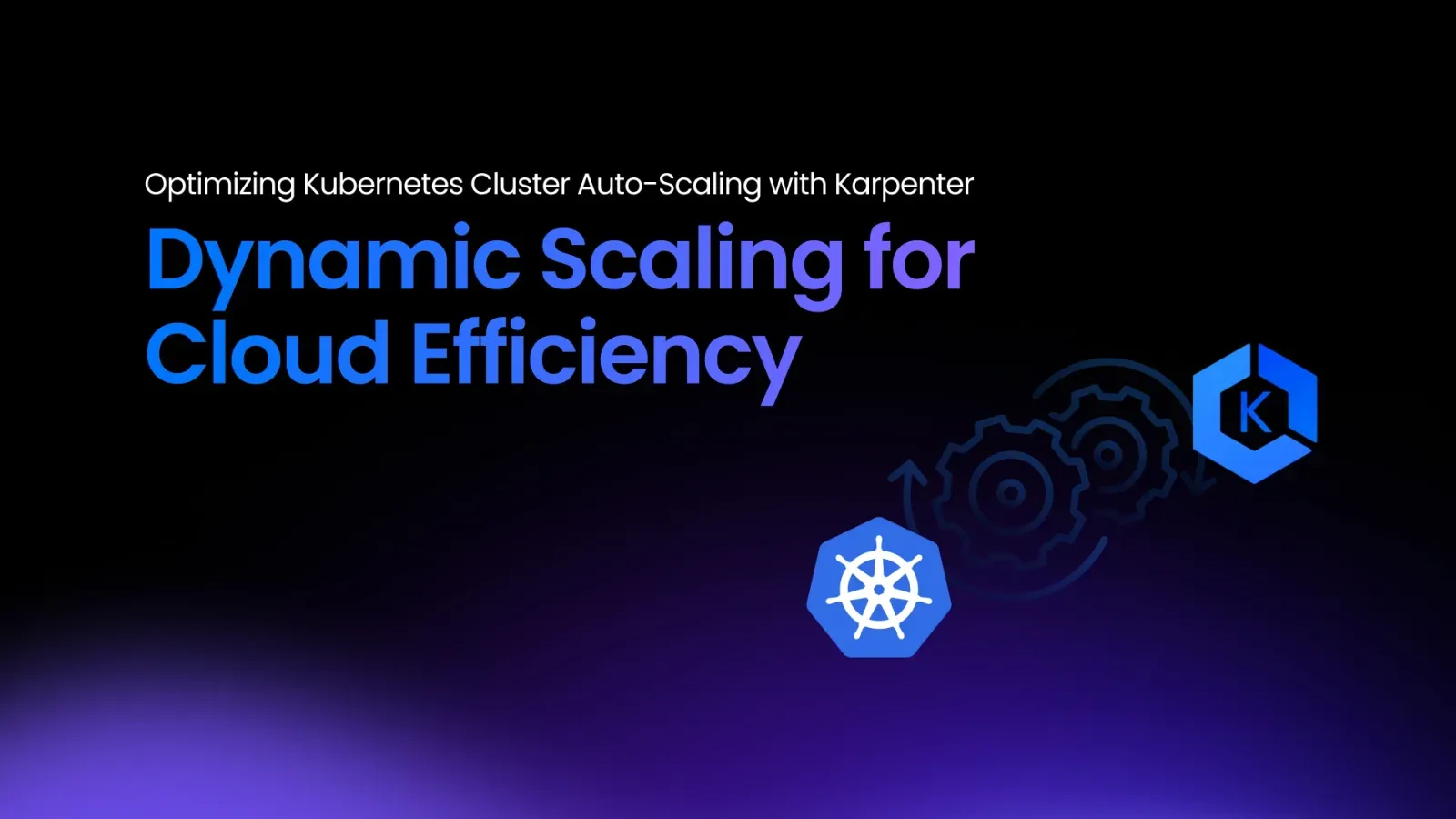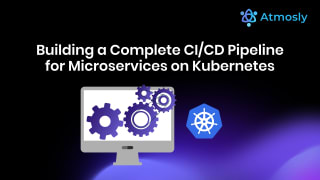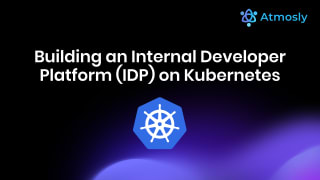Introduction
Kubernetes is the new management backhaul of how we run our containerized workloads in the case of cloud-native applications. Its capability to automate almost everything that needs to happen - from deployment to scaling and, in fact, the management of the application itself-puts it as one of the front choices for modern infrastructures. The growth in applications' complexity, however, calls for efficient management of the underlying infrastructure, especially when scaling up or down in real-time.
Autoscalers in general, like HPA and CA, have proven to be very handy but with limitations. It is really good at adjusting pod resources about use of CPU or memory but CA reacts pretty slow. It is also bound to node groups, and depending on traffic, things can get pretty inefficient, especially during spikes of traffic. This can lead to loss of resources or even downtime during peak seasons.
That is where Karpenter comes in. Karpenter is a free, open-source autoscaling tool for optimizing how Kubernetes clusters handle scaling. Unlike the old Cluster Autoscaler, Karpenter dynamically provisions nodes in real time based on what your workloads actually need. It improves performance and also helps cut costs by using spot instances and resizing nodes to exactly match the cluster's demands. Here, we will delve into how Karpenter works, why it's a game-changer, and a few best practices to get the most out of it.
Auto-Scaling in Kubernetes: A Quick Overview
Before delving into Karpenter’s unique features, it's important to understand the core mechanisms Kubernetes uses for scaling.
Horizontal Pod Autoscaler (HPA)
The HPA is designed to scale the number of pods in response to changing resource demands. It does this by monitoring metrics like CPU utilization or memory usage and scaling the number of replicas accordingly. For instance, if an application’s CPU usage exceeds 80% for a sustained period, the HPA can automatically trigger additional pods to handle the load.
While the HPA is ideal for handling pod-level scaling, it doesn’t address node-level scaling. This is where the Cluster Autoscaler comes in.
Cluster Autoscaler (CA)
This means that the nodes of the cluster will add or remove nodes based on the resource requests needed by those running pods on the cluster. If there are pods not scheduled, which is due to resource constraints, then the CA would add more nodes. If these pods are no longer required and if their resources are also not under usage, then the CA scales down again by deleting the nodes that are considered unnecessary.
However, the Cluster Autoscaler has some constraint on its use. The scale relies on pre-defined node groups, which means scaling an entire node pool in one go and does not bestow the scalability authority on the choice of node type for a given workload. This often results in wastage of resources as certain nodes are underutilized, primarily if the nodes are not sized well for the needs of the application.
Challenges of Traditional Autoscalers
While these mechanisms work well in many scenarios, they are not without their shortcomings. The Cluster Autoscaler can be slow to respond to rapid changes in demand, and node pools often result in over-provisioning of resources. Furthermore, the process of manually configuring these node pools can add complexity, especially when working with multiple cloud providers or hybrid environments.
What to Know About Karpenter
Karpenter addresses many of the limitations of traditional autoscalers by taking a more dynamic, cloud-native approach to scaling.
What is Karpenter?
Karpenter is a Kubernetes-native autoscaler that dynamically provisions nodes based on real-time demand. Rather than scaling predefined node groups, Karpenter interacts directly with the Kubernetes control plane and cloud provider APIs to create the most suitable node types for each workload.
Key Features of Karpenter

- Dynamic Node Provisioning: Karpenter can create new nodes on demand without relying on predefined node groups. This allows it to choose the exact instance type and size that best fits the workload's needs, minimizing waste.
- AWS Integration: While Karpenter is cloud-agnostic, it integrates tightly with AWS, leveraging EC2 Spot Instances for cost savings and automatically selecting the optimal instance types based on real-time pricing and availability.
- Speed: Karpenter provisions nodes in seconds, allowing it to respond quickly to changes in demand, such as traffic spikes, without the lag associated with the Cluster Autoscaler.
- Cost Optimization: By dynamically selecting the best instance type and leveraging Spot Instances, Karpenter significantly reduces the overall cost of running Kubernetes clusters, especially in environments with unpredictable traffic.
How Karpenter Works
Karpenter’s real-time provisioning and optimization capabilities set it apart from traditional autoscalers. Here’s how it works:
Dynamic Provisioning of Nodes
Unlike traditional autoscalers that scale up by adding nodes from predefined groups, Karpenter dynamically provisions nodes based on real-time pod requirements. It directly interacts with the Kubernetes scheduler to determine which pods need resources and provisions the exact resources needed to satisfy those requirements. This allows Karpenter to optimize node sizes, types, and availability zones on the fly.
Integration with the Kubernetes Scheduler
Karpenter integrates deeply with the Kubernetes scheduler. Whenever the scheduler detects that there are unschedulable pods (e.g., due to a lack of available CPU or memory), Karpenter kicks in to provision the necessary resources. It evaluates the resource requirements of the pods and then provisions nodes that can meet those demands, whether it's a general-purpose instance, a high-memory instance, or a compute-optimized instance.
Leveraging Spot Instances
One of Karpenter’s most significant advantages is its ability to leverage AWS Spot Instances, which are significantly cheaper than on-demand instances. Spot Instances are ideal for workloads that can tolerate interruptions, making Karpenter a perfect fit for non-critical, scalable applications.
Cost Optimization and Efficiency
By dynamically choosing the right instance type for the job, Karpenter reduces over-provisioning and ensures that resources are used efficiently. For example, instead of adding a large general-purpose instance to handle a memory-intensive application, Karpenter might provision a high-memory instance specifically for that workload, ensuring better resource utilization and lower costs.
Setting Up Karpenter in Your Kubernetes Cluster
Implementing Karpenter in your Kubernetes cluster involves a few key steps:
Installation Prerequisites
Before installing Karpenter, you need a Kubernetes cluster running version 1.25 or later. Additionally, you must have AWS IAM roles configured for Karpenter to interact with EC2 and other AWS services.
Step-by-Step Installation Guide
Deploy Karpenter Using Helm:
Karpenter can be installed using Helm, a package manager for Kubernetes. Start by adding the Karpenter Helm repository and installing the controller:
helm repo add karpenter https://charts.karpenter.sh
helm repo update
helm install karpenter karpenter/karpenter --namespace karpenter
Configuring AWS IAM Roles:
You’ll need to create IAM roles that allow Karpenter to provision and manage EC2 instances. These roles should have policies attached that grant permissions for actions such as launching instances, attaching volumes, and managing networking.
Example command to create an IAM role:
aws iam create-role --role-name KarpenterRole
--assume-role-policy-document file://trust-policy.jsonCreating Karpenter Provisioners:
Provisioners define the criteria for node creation in Karpenter. This includes the instance types, capacity types (e.g., spot or on-demand), and availability zones that Karpenter can use when provisioning nodes. The provisioner can be configured as follows:
apiVersion: karpenter.sh/v1alpha5
kind: Provisioner
spec:
requirements:
- key: "kubernetes.io/arch"
operator: In
values: ["amd64"]
- key: "topology.kubernetes.io/zone"
operator: In
values: ["us-west-2a", "us-west-2b"]
provider:
instanceProfile: "KarpenterInstanceProfile"
tags:
karpenter.sh/capacity-type: spotOptimizing Cluster Auto-Scaling with Karpenter
Once Karpenter is up and running in your Kubernetes environment, the next step is optimizing its configuration to ensure you're getting the most out of its dynamic provisioning capabilities. Here are some best practices and tips for ensuring efficient Kubernetes auto-scaling using Karpenter.
1. Right-Sizing Instance Types for Workloads
One of the key advantages of Karpenter over traditional autoscalers is its ability to dynamically provision the right instance types for the workload. To ensure optimal performance, it’s crucial to accurately define the resource requests (CPU, memory) for each pod.
For example:
- High-memory workloads should use memory-optimized instance types (such as r5.large).
- Compute-intensive applications can benefit from compute-optimized instances (such as c5.xlarge).
By configuring Karpenter to provision instance types based on the specific resource requirements of your pods, you can avoid resource underutilization and over-provisioning. This allows your Kubernetes cluster to operate more efficiently and reduces the overall cloud cost.
2. Leveraging Spot Instances for Cost Efficiency
Spot instances, available at a fraction of the price of on-demand instances, are an essential component for reducing cloud infrastructure costs. Karpenter can be configured to prioritize spot instances for non-critical workloads.
- Best Practice: Define provisioners to automatically select spot instances where possible. Spot instances work well for workloads that can tolerate occasional interruptions, such as batch jobs or machine learning training processes.
By integrating spot instances into your Kubernetes cluster via Karpenter, you can take advantage of the cost savings without sacrificing performance for high-priority workloads.
3. Defining Provisioners for Fine-Tuned Control
Provisioners allow you to define the constraints under which Karpenter will provision new nodes. This includes choosing specific instance types, availability zones, capacity types (on-demand or spot), and more.
Example configuration for a Provisioner that uses spot instances across multiple availability zones:
apiVersion: karpenter.sh/v1alpha5
kind: Provisioner
spec:
requirements:
- key: "topology.kubernetes.io/zone"
operator: In
values: ["us-east-1a", "us-east-1b"]
- key: "karpenter.sh/capacity-type"
operator: In
values: ["spot"]
provider:
instanceProfile: "KarpenterInstanceProfile"
securityGroups:
- sg-0123456789abcdef
limits:
resources:
cpu: "100"
memory: "512Mi"This ensures that your nodes are created based on your specific needs, further optimizing the use of resources.
Monitoring Performance with Observability Tools
To effectively manage and optimize Karpenter in a production environment, it’s essential to implement robust monitoring and observability practices. Tools like Prometheus and Grafana can help you track key metrics, including:
- Node provisioning times
- CPU and memory utilization per pod and per node
- Spot instance lifecycle events
- Scaling events and triggers
By monitoring these metrics, you can fine-tune Karpenter’s behavior and ensure that it scales efficiently in response to your workloads. Alerts can also be set up to notify you of any resource bottlenecks or issues with spot instance availability.
Combining Karpenter with Horizontal Pod Autoscaler (HPA)
While Karpenter is responsible for scaling nodes, the Horizontal Pod Autoscaler (HPA) scales pods. When these two tools are used together, Kubernetes can scale both the application layer and the infrastructure layer simultaneously.
- HPA adjusts the number of pods based on resource metrics like CPU and memory usage.
- Karpenter dynamically provisions new nodes to handle the additional pods when the current nodes are at full capacity.
Together, these tools provide a comprehensive, automated scaling solution that ensures high availability and efficient resource utilization during traffic spikes.
Optimizing Resource Requests and Limits
Karpenter relies on the resource requests defined in your pod specifications to determine how much compute power and memory a workload requires. By ensuring that each pod’s requests and limits are configured correctly, Karpenter can more accurately provision nodes with the appropriate resources.
apiVersion: v1
kind: Pod
metadata:
name: web-server
spec:
containers:
- name: nginx
image: nginx
resources:
requests:
memory: "64Mi"
cpu: "250m"
limits:
memory: "128Mi"
cpu: "500m"Setting accurate resource requests and limits ensures that your pods have enough resources to perform optimally without over-provisioning, which could lead to higher costs.
Comparing Karpenter with Traditional Cluster Autoscaler
Karpenter brings several advantages over the traditional Cluster Autoscaler (CA). Let’s break down the key differences between these two tools.
1. Scaling Mechanism
The Cluster Autoscaler works by adding or removing nodes from pre-configured node groups. These node groups are often set up with specific instance types and fixed capacity, meaning that scaling is somewhat rigid.
In contrast, Karpenter provisions nodes dynamically, choosing the most appropriate instance type and capacity based on the current demands of the cluster. This dynamic nature allows Karpenter to react more quickly and more efficiently to changes in workload demands.
2. Instance Type Flexibility
The Cluster Autoscaler is limited to the instance types and sizes specified in the node group configurations. This can lead to inefficiencies, particularly when the predefined instances are too large or too small for the workloads they are intended to handle.
Karpenter, on the other hand, can provision a wide variety of instance types based on the exact resource needs of the workload, reducing both resource underutilization and waste.
3. Speed of Scaling
The traditional Cluster Autoscaler can take several minutes to scale up or down, especially in environments with many node pools. Karpenter, however, is designed to react in seconds, ensuring that your cluster scales as quickly as possible in response to changing demand.
For workloads with unpredictable spikes in traffic, such as e-commerce sites during sales events or video streaming platforms during live broadcasts, Karpenter’s fast response times can be a critical advantage.
Cost Optimization
While the Cluster Autoscaler can help reduce costs by scaling down underutilized nodes, it doesn’t offer the same level of cost optimization as Karpenter. By leveraging spot instances and dynamically selecting the most cost-effective resources, Karpenter can significantly reduce cloud infrastructure costs.
Conclusion: Why Karpenter is the Future of Kubernetes Auto-Scaling
Karpenter is actually a huge leap forward in Kubernetes auto-scaling, ensuring that Kubernetes clusters can scale at maximal speed, minimizing and reducing wastage of resources as well as cloud infrastructure costs, through dynamic real-time provisioning of nodes.
Karpenter is thus the modern flexible new alternative in such organizations with elastic workloads or those trying to minimize the cost of utilizing the clouds from the traditional autoscalers. Using spot instances, right-sizing, and fast response time, Karpenter sets a benchmark in the new paradigm of auto-scaling a Kubernetes cluster.






